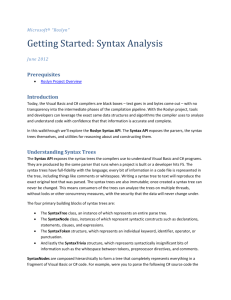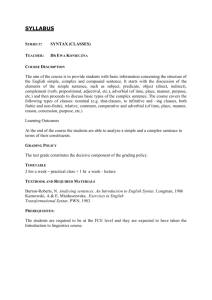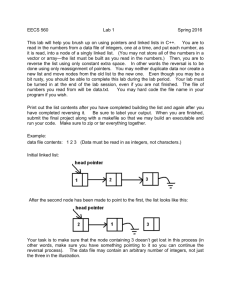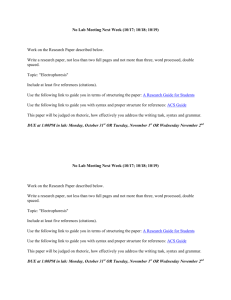Syntax Analysis and Getting Started: Semantic Analysis
advertisement
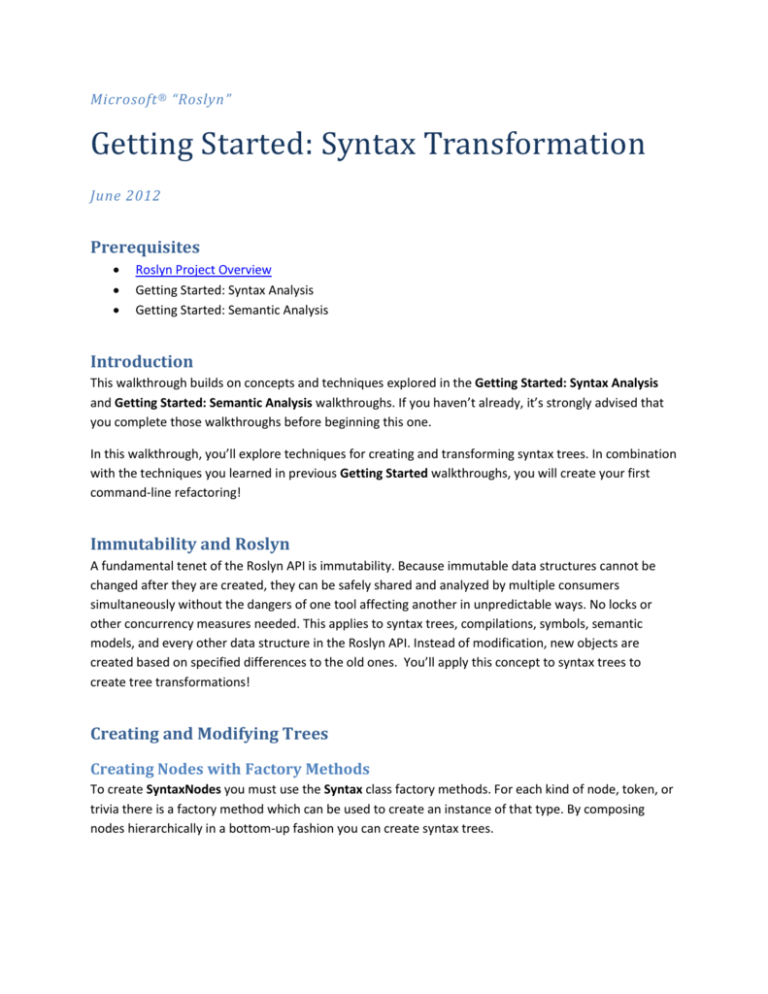
Microsoft ® “Roslyn”
Getting Started: Syntax Transformation
June 2012
Prerequisites
Roslyn Project Overview
Getting Started: Syntax Analysis
Getting Started: Semantic Analysis
Introduction
This walkthrough builds on concepts and techniques explored in the Getting Started: Syntax Analysis
and Getting Started: Semantic Analysis walkthroughs. If you haven’t already, it’s strongly advised that
you complete those walkthroughs before beginning this one.
In this walkthrough, you’ll explore techniques for creating and transforming syntax trees. In combination
with the techniques you learned in previous Getting Started walkthroughs, you will create your first
command-line refactoring!
Immutability and Roslyn
A fundamental tenet of the Roslyn API is immutability. Because immutable data structures cannot be
changed after they are created, they can be safely shared and analyzed by multiple consumers
simultaneously without the dangers of one tool affecting another in unpredictable ways. No locks or
other concurrency measures needed. This applies to syntax trees, compilations, symbols, semantic
models, and every other data structure in the Roslyn API. Instead of modification, new objects are
created based on specified differences to the old ones. You’ll apply this concept to syntax trees to
create tree transformations!
Creating and Modifying Trees
Creating Nodes with Factory Methods
To create SyntaxNodes you must use the Syntax class factory methods. For each kind of node, token, or
trivia there is a factory method which can be used to create an instance of that type. By composing
nodes hierarchically in a bottom-up fashion you can create syntax trees.
Example – Creating a SyntaxNode using Factory Methods
This example uses the Syntax class factory methods to construct a NameSyntax representing the
System.Collections.Generic namespace.
NameSyntax is the base class for four types of names that appear in C#:
IdentifierNameSyntax which represents simple single identifier names like System and Roslyn
GenericNameSyntax which represents a generic type or method name such as List<int>
QualifiedNameSyntax which represents a qualified name of the form <left-name>.<rightidentifier-or-generic-name> such as System.IO
AliasQualifiedNameSyntax which represents a name using an assembly extern alias such a
LibraryV2::Foo
By composing these names together you can create any name which can appear in the C# language.
1) Create a new C# Roslyn Console Application project.
In Visual Studio, choose File -> New -> Project… to display the New Project dialog.
Under Visual C# -> Roslyn, choose “Console Application”.
Name your project “ConstructionCS” and click OK.
2) Press F10 to begin executing the program.
3) First create a simple IdentifierNameSyntax representing the name of the System namespace
and assign it to a variable. As you build up a QualifiedNameSyntax from this node you will reuse
this variable so declare this variable to be of type NameSyntax to allow it to store both types of
SyntaxNode – DO NOT use type inference:
NameSyntax name = Syntax.IdentifierName("System");
4) Press F10 to execute this statement.
5) Press Ctrl+Alt+I to open the Immediate Window.
6) Using the Immediate Window type the expression name.GetText() and press Enter to evaluate
it. You should see the string “System” as the result.
7) Next, construct a QualifiedNameSyntax using this name node as the left of the name and a new
IdentifierNameSyntax for the Collections namespace as the right side of the
QualifiedNameSyntax:
name = Syntax.QualifiedName(name, Syntax.IdentifierName("Collections"));
8) Move your cursor to this line and press Ctrl+Shift+F10 to set this as the next statement to be
executed. Press F10 to execute the statement and set the name variable to the new
QualifiedNameSyntax node. You will need to repeat this process in the following steps as we
introduce new statements and inspect their effects with the debugger.
9) Using the Immediate Window evaluate the expression name.GetText(). It should evaluate to
“System.Collections”.
10) Continue this pattern by building another QualifiedNameSyntax node for the Generic
namespace:
name = Syntax.QualifiedName(name, Syntax.IdentifierName("Generic"));
11) Execute this statement and again use the Immediate Window to observe that name.GetText()
now evaluates to the fully qualified name “System.Collections.Generic”.
Modifying Nodes with With* and ReplaceNode Methods
Because the syntax trees are immutable, the Syntax API provides no direct mechanism for modifying an
existing syntax tree after construction. However, the Syntax API does provide methods for producing
new trees based on specified changes to existing ones. Each concrete class that derives from
SyntaxNode defines With* methods which you can use to specify changes to its child properties.
Additionally, the ReplaceNode extension method can be used to replace a descendent node in a
subtree. Without this method updating a node would also require manually updating its parent to point
to the newly created child and repeating this process up the entire tree – a process known as re-spining
the tree.
Example – Transformations using the With* and ReplaceNode methods.
This example uses the WithName method to replace the name in a UsingDirectiveSyntax node with the
one constructed above.
1. Continuing from the previous example above, add this code to parse a sample code file:
SyntaxTree tree = SyntaxTree.ParseCompilationUnit(
@"using System;
using System.Collections;
using System.Linq;
using System.Text;
namespace HelloWorld
{
class Program
{
static void Main(string[] args)
{
Console.WriteLine(""Hello, World!"");
}
}
}");
var root = (CompilationUnitSyntax)tree.GetRoot();
Note that the file uses the System.Collections namespace and not the
System.Collections.Generic namespace.
2. Execute these statements.
3. Create a new UsingDirectiveSyntax node using the UsingDirectiveSyntax.WithName method to
update the “System.Collections” name with the name we created above:
var oldUsing = root.Usings[1];
var newUsing = oldUsing.WithName(name);
4. Using the Immediate Window evaluate the expression root.GetText() and observe that the
original tree has not been changed to contain this new updated node.
5. Add the following line using the ReplaceNode extension method to create a new tree, replacing
the existing import with the updated newUsing node, and store the new tree in the existing root
variable:
root = root.ReplaceNode(oldUsing, newUsing);
6. Using the Immediate Window evaluate the expression root.GetText() this time observing that
the tree now correctly imports the System.Collections.Generic namespace.
7. Press Shift+F5 to stop the debugger.
8. Your Program.cs file should now look like this:
using
using
using
using
using
using
System;
System.Collections.Generic;
System.Linq;
System.Text;
Roslyn.Compilers;
Roslyn.Compilers.CSharp;
namespace ConstructionCS
{
class Program
{
static void Main(string[] args)
{
NameSyntax name = Syntax.IdentifierName("System");
name = Syntax.QualifiedName(name, Syntax.IdentifierName("Collections"));
name = Syntax.QualifiedName(name, Syntax.IdentifierName("Generic"));
SyntaxTree tree = SyntaxTree.ParseCompilationUnit(
@"using System;
using System.Collections;
using System.Linq;
using System.Text;
namespace HelloWorld
{
class Program
{
static void Main(string[] args)
{
Console.WriteLine(""Hello, World!"");
}
}
}");
var root = (CompilationUnitSyntax)tree.GetRoot();
var oldUsing = root.Usings[1];
var newUsing = oldUsing.WithName(name);
root = root.ReplaceNode(oldUsing, newUsing);
}
}
}
Transforming Trees using SyntaxRewriters
The With* and ReplaceNode methods provide convenient means to transform individual branches of a
syntax tree. However, often it may be necessary to perform multiple transformations on a syntax tree in
concert. The SyntaxRewriter class is a subclass of SyntaxVisitor which can be used to apply a
transformation to a specific type of SyntaxNode. It is also possible to apply a set of transformations to
multiple types of SyntaxNode wherever they appear in a syntax tree. The following example
demonstrates this in a naïve implementation of a command-line refactoring which removes explicit
types in local variable declarations anywhere where type inference could be used. This example makes
use of techniques discussed in this walkthrough as well as the Getting Started: Syntactic Analysis and
Getting Started: Semantic Analysis walkthroughs.
Example – Creating a SyntaxRewriter to transform syntax trees.
1) Create a new C# Roslyn Console Application project; name it “TransformationCS”.
2) Insert the following using directive at the top of your Program.cs file:
using System.IO;
3) On the menu click Project > Add Class… to add a new class file to your project. In the Add New Item
dialog type TypeInferenceRewriter.cs as the filename.
4) Add using directives for the Roslyn.Compilers namespace and the Roslyn.Compilers.CSharp
namespace.
5) Make the TypeInferenceRewriter class extend the SyntaxRewriter class:
public class TypeInferenceRewriter : SyntaxRewriter
{
6) Add the following code to declare a private read-only field to hold a SemanticModel and initialize it
from the constructor. You will need this field later on to determine where type inference can be
used:
private readonly SemanticModel SemanticModel;
public TypeInferenceRewriter(SemanticModel semanticModel)
{
this.SemanticModel = semanticModel;
}
7) Override the VisitLocalDeclarationStatement method:
public override SyntaxNode VisitLocalDeclarationStatement(
LocalDeclarationStatementSyntax node)
{
}
Note that the VisitLocalDeclarationStatement method returns a SyntaxNode, not
LocalDeclarationStatementSyntax. In this example you’ll return another
LocalDeclarationStatementSyntax node based on the existing one. In other scenarios one
kind of node may be replaced by another kind of node entirely – or even removed.
8) For the purpose of this example you’ll only handle local variable declarations, though type inference
may be used in foreach loops, for loops, LINQ expressions, and lambda expressions. Furthermore
this rewriter will only transform declarations of the simplest form:
Type variable = expression;
The following forms of variable declarations in C# are either incompatible with type inference or left
as an exercise to the reader
// Multiple variables in a single declaration.
Type variable1 = expression1,
variable2 = expression2;
// No initializer.
Type variable;
9) Add the following code to the body of the VisitLocalDeclarationStatement method to skip rewriting
these forms of declarations:
if (node.Declaration.Variables.Count > 1)
{
return node;
}
if (node.Declaration.Variables[0].Initializer == null)
{
return node;
}
Note that returning the node parameter unmodified results in no rewriting taking place for
that node.
10) Add these statements to extract the type name specified in the declaration and bind it using the
SemanticModel field to obtain a type symbol.
VariableDeclaratorSyntax declarator = node.Declaration.Variables.First();
TypeSyntax variableTypeName = node.Declaration.Type;
TypeSymbol variableType =
(TypeSymbol)SemanticModel.GetSymbolInfo(variableTypeName)
.Symbol;
11) Now, add this statement to bind the initializer expression:
TypeInfo initializerInfo =
SemanticModel.GetTypeInfo(declarator
.Initializer
.Value);
12) Finally, add the following if statement to replace the existing type name with the var keyword if the
type of the initializer expression matches the type specified:
if (variableType == initializerInfo.Type)
{
TypeSyntax varTypeName =
Syntax.IdentifierName("var")
.WithLeadingTrivia(
variableTypeName.GetLeadingTrivia())
.WithTrailingTrivia(
variableTypeName.GetTrailingTrivia());
return node.ReplaceNode(variableTypeName, varTypeName);
}
else
{
return node;
}
Note that this conditional is required because if the types don’t match the declaration may
be casting the initializer expression to a base class or interface. Removing the explicit type in
these cases would change the semantics of a program.
Note also that var is specified as an identifier rather than a keyword because var is a
contextual keyword.
Note that the leading and trailing trivia (whitespace) is transferred from the old type name
to the var keyword to maintain vertical whitespace and indentation.
Note also that it’s simpler to use ReplaceNode rather than With* to transform the
LocalDeclarationStatementSyntax because the type name is actually the grandchild of the
declaration statement.
13) Your TypeInferenceRewriter.cs file should now look like this:
using
using
using
using
using
using
System;
System.Collections.Generic;
System.Linq;
System.Text;
Roslyn.Compilers;
Roslyn.Compilers.CSharp;
namespace TransformationCS
{
public class TypeInferenceRewriter : SyntaxRewriter
{
private readonly SemanticModel SemanticModel;
public TypeInferenceRewriter(SemanticModel semanticModel)
{
this.SemanticModel = semanticModel;
}
public override SyntaxNode VisitLocalDeclarationStatement(
LocalDeclarationStatementSyntax node)
{
if (node.Declaration.Variables.Count > 1)
{
return node;
}
if (node.Declaration.Variables[0].Initializer == null)
{
return node;
}
VariableDeclaratorSyntax declarator = node.Declaration.Variables.First();
TypeSyntax variableTypeName = node.Declaration.Type;
TypeSymbol variableType =
(TypeSymbol)SemanticModel.GetSymbolInfo(variableTypeName)
.Symbol;
TypeInfo initializerInfo =
SemanticModel.GetTypeInfo(declarator
.Initializer
.Value);
if (variableType == initializerInfo.Type)
{
TypeSyntax varTypeName =
Syntax.IdentifierName("var")
.WithLeadingTrivia(
variableTypeName.GetLeadingTrivia())
.WithTrailingTrivia(
variableTypeName.GetTrailingTrivia());
return node.ReplaceNode(variableTypeName, varTypeName);
}
else
{
return node;
}
}
}
}
14) Return to your Program.cs file.
15) To test your TypeInferenceRewriter you’ll need to create a test Compilation to obtain the
SemanticModels required for the type inference analysis. You’ll do this step last. In the meantime
declare a placeholder variable representing your test Compilation:
Compilation test = CreateTestCompilation();
16) After pausing a moment you should see an error squiggle appear reporting that no
CreateTestCompilation method exists. Press Ctrl+Period to open the smart tag and then press Enter
to invoke the Generate Method Stub command. This will generate a method stub for the
CreateTestCompilation method in Program. You’ll come back to fill this in later:
17) Next, write the following code to iterate over each SyntaxTree in the test Compilation. For each one
initialize a new TypeInferenceRewriter with the SemanticModel for that tree:
foreach (SyntaxTree sourceTree in test.SyntaxTrees)
{
SemanticModel model = test.GetSemanticModel(sourceTree);
TypeInferenceRewriter rewriter = new TypeInferenceRewriter(model);
}
18) Lastly, inside the foreach statement you just created, add the following code to perform the
transformation on each source tree and conditionally write out the new transformed tree if any
edits were made. Remember, your rewriter should only modify a tree if it encountered one or more
local variable declarations that could be simplified using type inference:
SyntaxNode newSource = rewriter.Visit(sourceTree.GetRoot());
if (newSource != sourceTree.GetRoot())
{
File.WriteAllText(sourceTree.FilePath, newSource.GetFullText());
}
19) You’re almost done! There’s just once step left. Creating a test Compilation. Since you haven’t been
using type inference at all during this walkthrough it would have made a perfect test case.
Unfortunately, creating a Compilation from a C# project file is beyond the scope of this walkthrough.
But fortunately, if you’ve been following instructions very carefully there’s hope. Replace the
contents of the CreateTestCompilation method with the following code. It creates a test
compilation that coincidentally matches the project described in this walkthrough:
SyntaxTree programTree =
SyntaxTree.ParseCompilationUnit(
File.ReadAllText(@"..\..\Program.cs"),
@"..\..\Program.cs");
SyntaxTree rewriterTree =
SyntaxTree.ParseCompilationUnit(
File.ReadAllText(@"..\..\TypeInferenceRewriter.cs"),
@"..\..\TypeInferenceRewriter.cs");
List<SyntaxTree> sourceTrees = new List<SyntaxTree>();
sourceTrees.Add(programTree);
sourceTrees.Add(rewriterTree);
AssemblyNameReference mscorlib =
new AssemblyNameReference("mscorlib");
AssemblyNameReference roslynCompilers =
new AssemblyNameReference("Roslyn.Compilers");
AssemblyNameReference csCompiler =
new AssemblyNameReference("Roslyn.Compilers.CSharp");
List<MetadataReference> references = new List<MetadataReference>();
references.Add(mscorlib);
references.Add(roslynCompilers);
references.Add(csCompiler);
return Compilation.Create("TransformationCS",
CompilationOptions.Default,
sourceTrees,
references);
20) Your Program.cs file should look like this now:
using
using
using
using
using
using
using
System;
System.Collections.Generic;
System.IO;
System.Linq;
System.Text;
Roslyn.Compilers;
Roslyn.Compilers.CSharp;
namespace TransformationCS
{
internal class Program
{
private static void Main()
{
Compilation test = CreateTestCompilation();
foreach (SyntaxTree sourceTree in test.SyntaxTrees)
{
SemanticModel model = test.GetSemanticModel(sourceTree);
TypeInferenceRewriter rewriter = new TypeInferenceRewriter(model);
SyntaxNode newSource = rewriter.Visit(sourceTree.GetRoot());
if (newSource != sourceTree.GetRoot())
{
File.WriteAllText(sourceTree.FilePath, newSource.GetFullText());
}
}
}
private static Compilation CreateTestCompilation()
{
SyntaxTree programTree =
SyntaxTree.ParseCompilationUnit(
File.ReadAllText(@"..\..\Program.cs"),
@"..\..\Program.cs");
SyntaxTree rewriterTree =
SyntaxTree.ParseCompilationUnit(
File.ReadAllText(@"..\..\TypeInferenceRewriter.cs"),
@"..\..\TypeInferenceRewriter.cs");
List<SyntaxTree> sourceTrees = new List<SyntaxTree>();
sourceTrees.Add(programTree);
sourceTrees.Add(rewriterTree);
AssemblyNameReference mscorlib =
new AssemblyNameReference("mscorlib");
AssemblyNameReference roslynCompilers =
new AssemblyNameReference("Roslyn.Compilers");
AssemblyNameReference csCompiler =
new AssemblyNameReference("Roslyn.Compilers.CSharp");
List<MetadataReference> references = new List<MetadataReference>();
references.Add(mscorlib);
references.Add(roslynCompilers);
references.Add(csCompiler);
return Compilation.Create("TransformationCS",
CompilationOptions.Default,
sourceTrees,
references);
}
}
}
21) Cross your fingers and press F5 to run the project.
22) You should be prompted by Visual Studio that the files in your project have changed. Click “Yes to
All” to reload the modified files. Examine them to observe your awesomeness
Note how much cleaner the code looks without all those explicit and redundant type
specifiers.
23) Congratulations! You’ve just used the Roslyn Compiler APIs to write your own refactoring that
searches all files in a C# project for certain syntactic patterns, analyzes the semantics of source code
that matches those patterns, and transforms it. You’re now officially a Refactoring guru!
